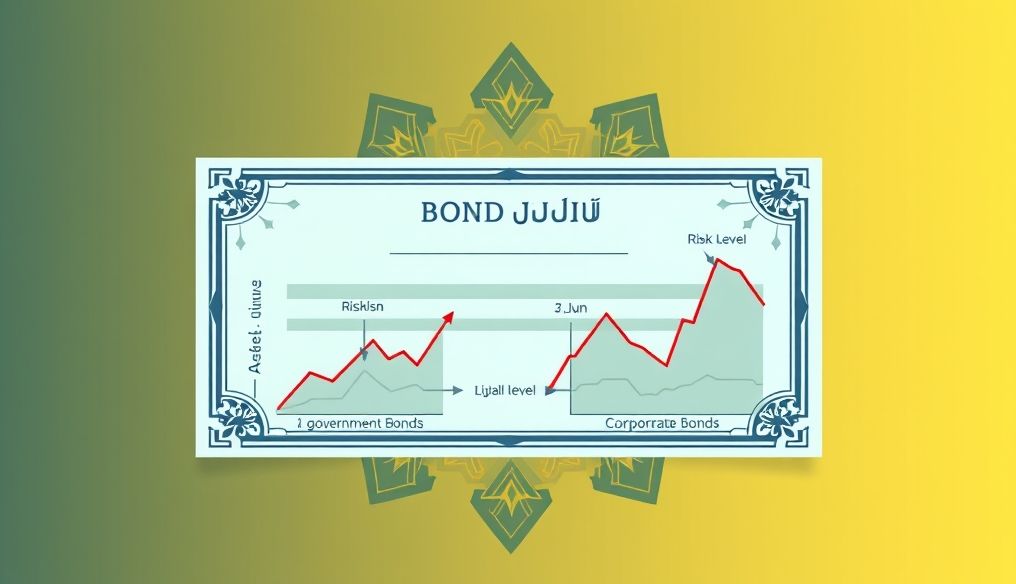Introduction: The World of Bonds in the Region
Government bonds and corporate bonds are important investment instruments in financial markets, playing a vital role in financing governments and companies. In the Middle East and North Africa (MENA) region, interest in these instruments is growing with the development of financial markets and the increasing need for financing by governments and companies.
Chapter 1: Defining Bonds and Their Types
What are Bonds?
A bond is a debt instrument representing a loan from an investor to the issuer (government or company). The issuer undertakes to pay periodic interest (coupon) and repay the principal amount (par value) on the maturity date.
Main Types of Bonds:
- Government Bonds: Issued by governments to finance public projects or to cover budget deficits.
- Corporate Bonds: Issued by companies to finance expansion, capital investments, or debt refinancing.
Chapter 2: Government Bonds: Safe Haven or Missed Opportunity?
Risks of Government Bonds:
Government bonds are generally considered less risky than corporate bonds, given the governments' ability to levy taxes and print money (in some cases). However, there are risks to consider:
- Inflation Risk: High inflation rates reduce the purchasing power of the fixed return offered by bonds.
- Interest Rate Risk: Rising interest rates make existing bonds less attractive, which may lead to a decrease in their market value.
- Sovereign Risk: In rare cases, governments may face difficulties in repaying their debts, leading to default.
Returns on Government Bonds:
Returns on government bonds are usually lower than those on corporate bonds, due to the lower level of risk. However, government bonds can provide a stable and reliable income for investors looking for a safe haven.
Example: U.S. Treasury bonds are considered one of the safest government bonds in the world, but their returns are usually lower than those of corporate bonds with similar credit ratings.
Chapter 3: Corporate Bonds: Rewarding Returns but with Higher Risks
Risks of Corporate Bonds:
Corporate bonds are riskier than government bonds, given the possibility of companies facing financial problems or bankruptcy.
- Credit Risk: The possibility that the company will not be able to repay its debts on time.
- Liquidity Risk: Difficulty in selling bonds quickly and at a fair price in the market.
- Industry Risk: The company's performance is affected by changes in the industry in which it operates.
Returns on Corporate Bonds:
Corporate bonds compensate investors for higher risks by offering higher returns than government bonds. Corporate bonds can be attractive to investors looking for high income and willing to take on a higher level of risk.
Example: Bonds of emerging companies in the technology sector may offer high returns, but they also carry high risks due to the instability of this sector.
Chapter 4: Direct Comparison: Government Bonds vs. Corporate Bonds
| Feature | Government Bonds | Corporate Bonds |
|---|---|---|
| Risk | Lower | Higher |
| Returns | Lower | Higher |
| Issuer | Government | Companies |
| Credit Rating | Depends on the sovereign rating of the country | Depends on the credit rating of the company |
Chapter 5: Factors Affecting Bond Prices
Bond prices are affected by several factors, including:
- Interest Rates: An inverse relationship between interest rates and bond prices.
- Inflation: Inflation affects the purchasing power of the fixed return, which affects bond prices.
- Economic Growth: Economic growth affects companies' ability to repay their debts, which affects corporate bond prices.
- Geopolitical Events: Global political and economic events can affect investor sentiment and thus bond prices.
Chapter 6: The Role of Credit Ratings in Bond Evaluation
A credit rating is an assessment of the issuer's ability to repay its debts on time. Credit rating agencies, such as Moody's, Standard & Poor's, and Fitch, evaluate bonds and assign them a credit rating. The higher the credit rating, the less risky the bond.
Chapter 7: Bonds in the Middle East and North Africa (MENA) Region
Bond markets in the Middle East and North Africa are characterized by their diversity and varying levels of development. Some countries, such as the United Arab Emirates, Qatar, and Saudi Arabia, have relatively developed bond markets, while bond markets in other countries are still in their early stages.
Example: Saudi Arabia has witnessed significant growth in the government and corporate bond market in recent years, as part of its efforts to diversify funding sources and implement Vision 2030.
Chapter 8: Bond Investment Strategies
There are several strategies that investors can follow when investing in bonds, including:
- Buy and Hold Strategy: Buying bonds and holding them until maturity.
- Bond Ladder Strategy: Building a portfolio of bonds with different maturity dates.
- Barbell Strategy: Investing in short-term and long-term bonds, while avoiding medium-term bonds.
Chapter 9: Tips for Bond Investors
Here are some tips for investors who want to invest in bonds:
- Do thorough research: Before investing in any bond, make sure you understand the potential risks and returns.
- Diversify your portfolio: Don't put all your money in one bond. Diversify your portfolio by investing in different bonds from different issuers.
- Monitor interest rates and inflation: These factors can affect bond prices.
- Consult a financial advisor: If you are unsure how to invest in bonds, seek advice from a qualified financial advisor.
Chapter 10: Conclusion and Future Outlook
Government bonds and corporate bonds are important investment instruments that can play a vital role in achieving your financial goals. However, it is important to understand the potential risks and returns of each before making an investment decision. Bond markets in the Middle East and North Africa are expected to continue to grow in the coming years, providing new opportunities for investors.




